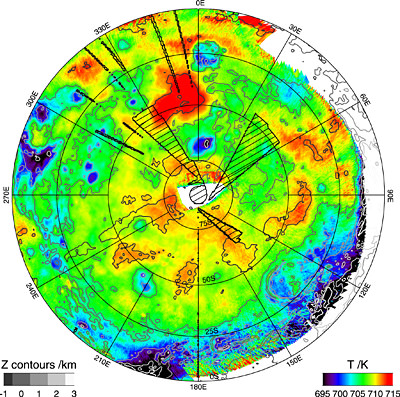[/caption]
Venus is often referred to as Earth’s twin, as the two planets share a similar size. But perhaps the similarities don’t end there. A new infrared map from Venus Express hints that our neighboring world may once have been more Earth-like, with a plate tectonics system and an ocean of water. While previous radar images have given us a glimpse of Venus’ cloud-shrouded surface, this is the first map that hints at the chemical composition of the rocks. The new data are consistent with suspicions that the highland plateaus of Venus are ancient continents, once surrounded by ocean and produced by past volcanic activity.
“This is not proof, but it is consistent. All we can really say at the moment is that the plateau rocks look different from elsewhere,” says Nils Müller at the Joint Planetary Interior Physics Research Group of the University Münster and DLR Berlin, who headed the mapping efforts.

The map shows Venus’ southern hemisphere comprised over a thousand individual images, recorded between May 2006 and December 2007. The Visible and Infrared Thermal Imaging Spectrometer (VIRTIS) instrument captured infrared radiation given off by the various surfaces on Venus during the spacecraft’s night-time orbits around the planet’s southern hemisphere.
Different types of rocks radiate different amounts of heat at infrared wavelengths owing to a material characteristic known as emissivity. The new map shows that the rocks on the Phoebe and Alpha Regio plateaus are lighter in color and look old compared to the majority of the planet. On Earth, such light-colored rocks are usually granite and form continents.
“If there is granite on Venus, there must have been an ocean and plate tectonics in the past,” says Müller.
Granite is formed when ancient rocks, made of basalt, are driven down into the planet by shifting continents, a process known as plate tectonics. The water combines with the basalt to form granite and the mixture is reborn through volcanic eruptions.
Müller points out that the only way to know for sure whether the highland plateaus are continents is to send a lander there. Over time, Venus’ water has been lost to space, but there might still be volcanic activity. The infrared observations are very sensitive to temperature. But in all images they saw variations of only 3–20°C, instead of the kind of temperature difference they would expect from active lava flows.
“Venus is a big planet, being heated by radioactive elements in its interior. It should have as much volcanic activity as Earth,” he says. Indeed, some areas do appear to be composed of darker rock, which hints at relatively recent volcanic flows.
Lead image caption: Artistic interpretation of a possible volcano on Venus. Credits: ESA – AOES Medialab
Source: ESA

Interesting.
Wasn’t there a recent paper suggesting that ocean conductivity might be factor in earths strong magnetosphere?
If true then when Venus had surface oceans it too should have had a strong magnetosphere, and plate tectonics.
The only thing missing then would be life in the form of biomass to create the carbon cycle.
Wonder if we could create a carbon cycle for it? Some form of organic aerosol perhaps? 🙂
Seems a shame to let a good sized planet go to waste… 🙂 Ok, at least I would say that Venus is a better candidate for terra-forming then Mars.
Damian K
Damian:
Terraforming of Venus.
You need to spin up the rotation of Venus. That would be no easy trick. Terraforming other planets is maybe not impossbile, but it is in my file of highly implausible outcomes.
Who came up with the term “Terraforming”?
Like LawrenceB. said: Highly implausible!
What are we? GOD’s? We are but a dust particle at the best of time in the grant picture of the UNIVERS! We are so minuscule in space that we can call ourself lucky to exsit!
Just observe and learn from the grand Master
who runs this show of what we call the UNIVERS!
And I’m do not belief in a GOD!
In one sense we are terraforming, but it is Earth and we are doing so in a negative direciton. We are tearing everything down.
Speculations about terraforming planets are just baby steps in a whole staircase of such ideas about so called civilization types I through IV, where at the last stage intelligent life is able to design up whole cosmologies (universes) and migrate into them. That would make terraforming Mars or Venus look like a Sunday afternoon walk in the park.
The warmings are pretty clear about our status on this planet,. If we are to manage a planet, or more to the point manage ourselves on this planet, we need to get cracking on it pretty quickly. We are not going to be able to order up new planets in the next 50-100 years.